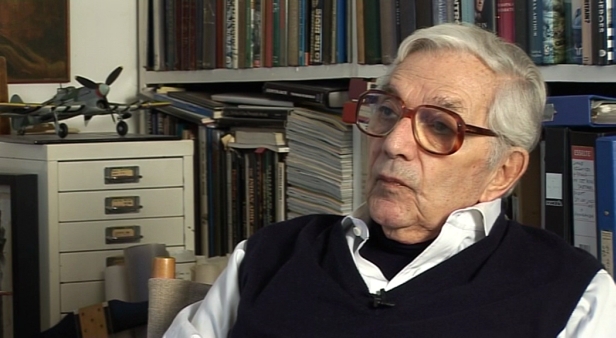NEXT STORY

Bailing out: 'We didn't have ejector seats in those days'
RELATED STORIES

NEXT STORY

Bailing out: 'We didn't have ejector seats in those days'
RELATED STORIES


|
Views | Duration | |
|---|---|---|---|
| 21. Pre-flight superstitions | 172 | 01:11 | |
| 22. The Falaise Gap: the smell of death | 276 | 03:40 | |
| 23. 'We used to miss a lot of targets' | 155 | 01:01 | |
| 24. Reunion at Duxford | 160 | 02:15 | |
| 25. Belsen concentration camp | 236 | 02:36 | |
| 26. Distractions from the heavy impact of the war | 149 | 01:05 | |
| 27. Everlasting bonds with fellow pilots | 186 | 02:55 | |
| 28. Bailing out: 'We didn't have ejector seats in those days' | 161 | 03:26 | |
| 29. Spending another year in Germany after the war | 256 | 01:01 | |
| 30. Riverside Studios: how I got started in film | 186 | 02:11 |


The thing that amazed me is this completely different relationship that you kept... one kept going with people you had flown with... you know? And there are very few... I mean, I get now letters from a Canadian pilot who enlisted in Canada, and he was in 609, but the courage of some of these people is unbelievable. He was... he joined 609 Squadron quite a time before me, because he flew a Hurricane from the deck of a convoy ship, you know. And all they did, they had a sort of catapult, and when a German aircraft or something came over the deck or a submarine, they were catapulted into the air. But they... you know, they either had to bale out, which was dangerous enough, or they had to ditch the plane and come out that way, and that's what they did. And then, instead of having had enough, you know, of having had to ditch the plane, he joined 609 Squadron, and after three or four weeks he was shot down over France, and we didn't know what had happened to him, because normally you followed somebody down. And he was picked up by the French Resistance and lived in Paris in quite great style and was in a film by the Germans as a... French... you know, extra, or something like that, until they found him out and then he was shoved into one of the concentration camps. But there was… the war was nearly over by that time.
And so this is the… but you know, I would have never had that courage, you know, first of all flying from a bloody boat, knowing that you can't get back because, you know, baling out is not that… we didn't have ejector seats.
Sir Kenneth Adam (1921-2016), OBE, born Klaus Hugo Adam, was a production designer famous for his set designs for the James Bond films of the 1960s and 1970s. Initially, he trained as an architect in London, but in October 1943, he became one of only two German-born fighter pilots to fly with the RAF in wartime. He joined 609 Squadron where he flew the Hawker Typhoon fighter bomber. After the war, he entered the film industry, initially as a draughtsman on This Was a Woman. His portfolio of work includes Barry Lyndon and The Madness of King George; he won an Oscar for both films. Having a close relationship with Stanley Kubrick, he also designed the set for the iconic war room in Dr Strangelove. Sir Ken Adam was knighted by Queen Elizabeth II in 2003.
Title: Everlasting bonds with fellow pilots
Listeners: Christopher Sykes
Christopher Sykes is an independent documentary producer who has made a number of films about science and scientists for BBC TV, Channel Four, and PBS.
Tags: Canada, 609 Squadron, France, French Resistance, Paris, World War II
Duration: 2 minutes, 55 seconds
Date story recorded: December 2010 and January 2011
Date story went live: 15 August 2011